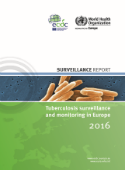Tuberculosis surveillance and monitoring in Europe 2016

Download
This is the eighth report launched jointly by the European Centre for Disease Prevention and Control (ECDC) and the WHO Regional Office for Europe following on from reports under the EuroTB project, established in 1996.
Despite some positive developments (e.g. the sharp decrease in TB incidence, the increase in DST coverage and improved access to MDR diagnosis and treatment), the WHO European Region did not meet its target of halving TB prevalence and mortality, as set out in the Stop TB Strategy 2007–2015.
TB continues to be a major public health issue in the WHO European Region. According to the latest estimates, about 340 000 new TB cases and 33 000 deaths were reported in the Region in 2014, mostly from eastern and central European countries.
Together with its partners, WHO's Regional Office for Europe supports European countries in their work to prevent and control TB and M/XDR-TB. This includes setting norms and standards, providing technical assistance, fostering partnerships, building capacity, creating and disseminating evidence, and conducting monitoring and evaluation.
The year 2015 marks the end of the Consolidated Action Plan to Prevent and Combat Multidrug- and Extensively Drug-Resistant Tuberculosis in the WHO European Region. In order to continue to move forward and address the challenges in tuberculosis and M/XDR-TB prevention and care, the WHO Regional Office for Europe has developed the new 'Tuberculosis action plan for the WHO European Region 2016–2020'. This action plan is based on lessons learned implementing the seven areas of intervention in the Consolidated Action Plan in line with the global End TB Strategy and other health policy guidance, such as Health 2020: the European policy for health and wellbeing.



